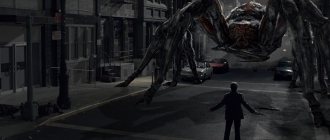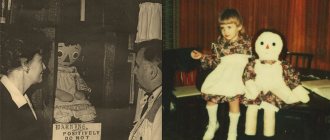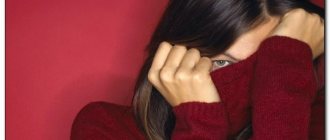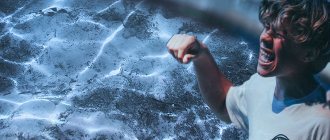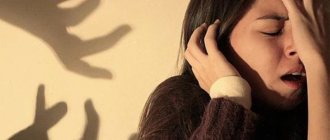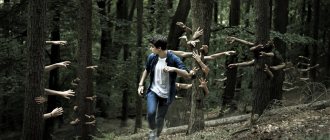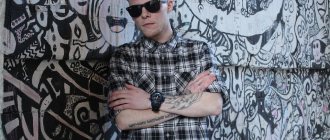- What is fear of crowds called?
- Manifestations of fear of crowds as a phobia
- Demophobia and ochlaphobia - is there a difference?
- Phobia or fear of large crowds?
And although man is a social creature, some would even say a herd, for one reason or another many do not like to be among large crowds of people. However, for some this only causes discomfort, while for others this dislike is very pronounced and is classified as a phobia. What is it called? As a rule, three main terms are associated with the fear of crowds - agoraphobia (one of the manifestations), demophobia and ochlophobia . Let's figure out what these phobias are and how they are characterized.
General information
Have you ever wondered what the fear of people is called?
Back in 1910 Chudinov A.N. used the term anthropophobia . ICD-10 code – F40.1 Social phobias. This is a type of social phobia that causes negative reactions and panic states during communication, contact, the presence in life of such objects of fear as a person or group of people of a certain profession, social status, or regardless of the type of detail, age and other characteristics of individuals.
What do you call fear of crowds?
The broadest and most well-known term is agoraphobia (some experts even say that it is the only correct one, while the rest, including demophobia and ochlophobia, are either its partial synonyms or outdated concepts).
Agoraphobia is better known as
the fear of open space
and in this regard is contrasted with one of the most famous phobias - claustrophobia, or fear of enclosed spaces.
How is the fear of open places related to the fear of crowds?
The fact is that these two phobias have similar mechanisms of occurrence, forms of manifestation and treatment. Their interaction is reflected even in the name: the word “agoraphobia” consists of two ancient Greek words “square” and “fear”, and the square, as a rule, is not only an open space, but also a very crowded one, especially in those times when the concept was formed.
Some classify those who are afraid of crowds as social phobics, but this is not entirely correct (although one does not exclude the other). And even more so, you shouldn’t call such people sociopaths.
Pathogenesis
People suffering from anthropophobia typically feel uncomfortable and stressed when interacting with others, especially strangers.
The main manifestation of the disease is voluntary social isolation, distrust and suspicion of other persons.
It all starts either with traumatic circumstances, violence, or with difficulties in establishing contact with the environment. A person begins to close himself off and realize that it is better for him to be alone, and avoids strangers. In the future, contact with others like oneself is reduced to a minimum, and in cases where interaction occurs, it becomes traumatic and causes stress .
As a result, a destructive defensive behavior pattern develops.
Basic information about demophobia
There are two main terms that mean the same thing - demophobia (literally - fear of people) and oxlophobia (literally - fear of crowds). There is also agoraphobia, which is often confused with demophobia. But these are fears of different etiology, and we will distinguish the differences later.
About 0.4% of the total population suffers from demophobia. These are mainly residents of large and densely populated cities.
Pathology refers to functional mental disorders of a reversible nature.
When there is heavy traffic and traffic jams on the road, hypermarkets are full of people, public transport is crowded, and you can’t find a free table in a cafe at lunch – you begin to get mentally tired. Even for those who do not suffer from phobias, being in a crowd can cause irritation and even aggression.
Some people are able to mentally abstract themselves from the masses and everything that happens around them. Others react to any external stimuli and experience stress. But there are those who have large crowds of people and bustle, causing panic.
Often, a demophobe cannot explain what exactly frightens him in a crowd. It is completely natural to feel fear in a crowd that has experienced general panic (for example, during a terrorist attack in a public place).
In such situations, people running, scared, create a powerful force that can destroy many obstacles in its path. Everyone knows that in such situations there are victims, crushed and trampled.
But with demophobia, a person begins to be frightened by absolutely any crowds of people, even completely peaceful ones. It is extremely difficult for a demophobe to travel on public transport during rush hours or enter premises with large crowds of people. And various folk festivals, rallies, parades with noise and drunk people can cause severe panic.
A person with oxlophobia experiences obsessive thoughts and constantly imagines negative pictures associated with their fear.
When the phobia is severe, the sufferer begins to experience unpleasant symptoms, even when simply observing a crowd, for example, on a TV screen or looking out a window.
On a note! A person suffering from a phobia is not affected by persuasion, such as: “calm down, there is no danger here” or “stop beating yourself up.” He is aware of his pathological fear, but is unable to control it, and is unable to cope with the reaction of his psyche.
Classification
Fear of society
Fear of one's own kind ( anthropophobia , from Greek anthropos - person, phobos - fear) is one of the most severe forms of phobias, because with arachno- or aerophobia it is possible to exclude traumatic factors - spiders and flights, and with anthropophobia it is almost impossible to avoid society around the clock.
Fear of contact with any person makes the patient’s life as uncomfortable as possible. After all, we are all social beings, with our own needs and life tasks, for example, the need for self-development, reproduction, career growth. However, it should not be confused with a state where a person is afraid to perform social actions. If a person is being watched by an imaginary or actual person (group of persons), then this is already social phobia .
Fear of crowds
The fear of large crowds of people is called demophobia . Unlike anthropophobia, the patient does not experience fear when interacting with individuals; panic attacks and stress develop only in crowded places. It is much simpler and easier to cope and live with such a problem; it is enough to avoid large companies.
Fear of men
Social phobia in which males are the object of fear is called androphobia . It occurs more often in women, but there are cases where it was also diagnosed in men.
Like other psychological disorders, androphobia is treatable, but many patients are afraid to admit that they suffer from this problem. The reasons for the fear of men lie in the experience of violence, cruelty, unsuccessful first sexual experiences, and even constant unflattering statements from those around them towards men, watching films with male aggressor protagonists.
In clinical practice, there are other types of anthropophobia; there are cases when patients are afraid of people of a certain profession (for example, most often dentists and other doctors), a certain age, social status (superiors), etc.
How demophobes see the world
Research in the field of psychiatry has revealed that fear of crowds arises at a conscious age. According to doctors, demophobia is a unique disease, since other phobias develop in childhood.
The source of fear can be the crowd as a whole, and the need to perform various actions while being among a large crowd of people. Fear of losing control over the situation leads to the development of a panic attack, since people are perceived by demophobes as a source of potential danger. In some cases, the cause of panic may be the fear of getting into a traumatic situation experienced previously. The same factor can cause the disorder itself.
According to experts, fear of a large number of people is one of the manifestations of basic instincts. In this case, the instinct of self-preservation takes on an aggravated form. People suffering from this disorder avoid going to various public places because they feel threatened by the people around them . In order to feel comfortable, they need to close themselves off from the outside world in a familiar place where they can feel safe.
Causes
Fear of people is a phobia, but like other problems of a psychological nature, it arises at an early age, namely in adolescence, when the psyche is most unstable and unformed, regardless of gender.
Among the main reasons are:
- low self-esteem and individual failures;
- fear of criticism and the risk of embarrassment;
- chronic psychotraumatic effects (for example, overly strict upbringing);
- physical, sexual or mental violence.
However, there are cases where fear of people also occurred in adults after experiencing an extreme traumatic event.
First aid for an attack of demophobia
This mental illness should be treated. It is best to visit a doctor. To do this you need to go out into society. This means that the likelihood of developing a panic attack still remains. Therefore, it is imperative to know how to help yourself during an attack:
- You can look at those around you, making sure that they are busy with their own affairs and have no intentions of harming the patient.
- Communication with a very close person helps in a panic attack. It’s good if he’s nearby, but if not, just call him on the phone.
- For a demophobe, the crowd is a single aggressive creature. Some psychologists advise combating this feeling by talking to one of the people: asking for the time or directions.
- You can bring yourself to life with cold water. You need to moisten your whiskey with it and drink in small sips.
- Those who are prone to panic attacks are recommended to master the breathing technique, using it to normalize heart rate and blood pressure at the right moments.
Important! A panic attack can be a one-time occurrence, or it can happen more than once. It is impossible to say how many times this will happen, but a demophobe must be prepared for anything when leaving the house.
Demophobia, like any disease, should be taken seriously, without starting it, taking measures immediately after detection.
Symptoms
Fear of strangers when interacting with objects of fear is accompanied by:
- experiencing negative emotions (anxiety, anger, concern for one’s own safety);
- development of severe vegetative reactions ( tremor , vomiting , hyperemia , profuse sweating , involuntary urination and defecation, etc.)
Anthropophobia in a person causes the development of compulsive behavior - actions that are defensive in nature and repeated in similar situations to prevent their development, for example:
- walking from corner to corner;
- muttering and talking to oneself;
- involuntary chaotic body movements;
- repeated hand washing;
- unbridled appetite and, as a result, stress eating.
How to treat demophobia
Mood swings in women and men - what is it called, why does it happen
A phobia of fear of crowds of people must be treated. Some patients simply try to adapt their life to it: leaving the house less, in moments of panic, trying to persuade themselves, to calm them down. You can't do that. This is because phobias, which are not paid attention to and which we constantly have to deal with, begin to progress and develop. It’s still not possible to completely lock yourself in a closed space for the rest of your life.
The only correct solution to overcoming crowd fear is to visit a psychiatrist or psychotherapist. The doctor will prescribe medications, prescribe special practices and trainings, selecting them individually. The simulation technique is often used: the doctor plays out this or that unexpected situation with the patient so that he learns to cope with fear.
Visiting a psychotherapist
Important! Under no circumstances should you self-medicate. We are talking about serious, strong drugs - tranquilizers and antidepressants. They should be strictly prescribed only by a specialist; their independent use can lead to health problems.
Treatment with folk remedies
There are several ways to strengthen the nervous system, achieve a sedative effect, and reduce nervousness and anxiety using medicinal plants and vegetable root vegetables:
- eat 200 g of carrots every day or drink a glass of freshly squeezed carrot juice;
- use 1 tbsp. infusion of aster chamomile, hawthorn or valerian 3-4 times a day (1 tablespoon of raw material is enough for a glass of boiling water);
- 1 teaspoon of tincture or ginseng root or leaves steamed in a glass of water (proportion 1:10);
- consume 100 ml of decoction of mint leaves in the morning and evening (1 tbsp mint per 200 ml of boiling water, which must be boiled for 10 minutes);
- 3 times a day, 30 minutes before meals, drink herbal tea with lemon balm leaves or 30-40 drops of motherwort juice .
In children
Social phobias have a more erased, variable nature; with age, the picture becomes more typical and clinically more defined. With anthropophobia in children, in most cases, motor disinhibition predominates, manifesting itself in the form of behavioral changes and decreased academic performance. The child’s emotional experiences affect the activity of internal organs and systems. Children also tend to focus heavily on a conflict situation, which easily leads to the emergence of fears.
Treatment and prognosis for children are more optimistic than for older people.

